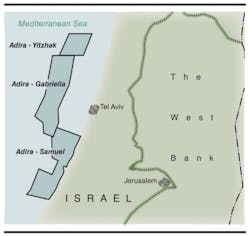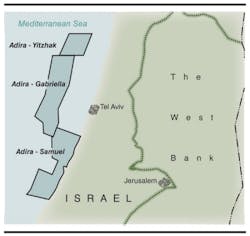Gene Kliewer • Houston
New streamer technology on fasttrack
Petroleum Geo-Services says it plans to accelerate deployment of its GeoStreamer technology ahead of its original schedule. PGS says half of its 3D fleet will have the streamers by the end of 2010.
“In the future all towed seismic acquisition will use dual sensors,” says Jon Erik Reinhardsen, president and CEO of PGS. “Oil is getting harder to find. For our clients it means more and better information from the reservoir.”
To date, the new technology has been used to collect 80,000 line km (49,710 mi) of 2D data and 8,500 sq km (3,282 sq mi) of 3D data in a variety of settings with improved data quality and operational reliability, says PGS.
Seismic acquisition active offshore Africa
Madagascar seismic data to be reprocessed
Some 6,000 line km (3,728 mi) of multi-client seismic data taken offshore Madagascar is to be reprocessed by Spectrum.
According to the agreement between Spectrum and OMNIS, the state agency responsible for upstream E&P in Madagascar, Spectrum will provide new datasets for open licensing blocks off the south and east coasts as well as the west coast where a line runs over both open and awarded blocks.
“We believe that reprocessing this data with Spectrum’s specialist seismic processing and imaging techniques will improve the quality and definition of the vintage data, particularly in less understood areas such as Cap St. Marie basin and Ile St. Marie,” says Charles Harmer, Spectrum EVP of Multi-Client.
Work is scheduled to be completed in 1Q 2010.
Liberia to see 3D survey
TGS-NOPEC Geophysical Co. has started another phase in its multi-client 3D acquisition project offshore Liberia. The new 2,000 sq km (772 sq mi) survey area expands on an existing 9,000 sq km (3,475 sq mi) 3D survey.
The new data will be recorded with long-offset acquisition, says TGS, and the data processing will include prestack time and depth processing.
Preliminary data is expected to be available in 3Q 2010.
“It is exciting to have data in a trend that has recently produced significant oil discoveries in offshore Africa,” says Kim Abdallah, TGS’ VP of New Ventures in Africa and the Middle East. “Our coverage of this emerging oil play will now be more than 14,000 km (8,699 mi) of multi-client 2D data and 11,000 sq km (4,247 sq mi) of 3D data.”
3D set off West Africa
An unnamed independent oil company has contracted Polarcus Ltd. for a two-month seismic acquisition project offshore West Africa.
Polarcus plans to use theNaila 12-streamer vessel for the project starting in 1Q 2010, pending governmental approval.
Low-frequency seismic JIP forms
A multi-year Joint Industry Project for R&D into low-frequency seismic use in upstream oil and gas is under way by Spectraseis. The Low Frequency Seismic Partnership participants include Cairn, Chevron, ExxonMobil, GDF Suez, and Pemex. Additional participants are expected, including Asian operators.
The scope of the LFSP covers application elements of low frequency seismic technology such as data acquisition and processing, as well as fundamental theoretical studies, in partnership with researchers at Spectraseis, the Swiss Federal Institute of Technology (ETH) in Zurich, and the University of Bern, Switzerland.
GoM exploration tools expand
MMS contracts TGS for log data management
The US Department of Interior Minerals Management Service has contracted TGS-NOPEC Geophysical Co. to manage well log data over the OCS for the next five years.
TGS acts as the collection point for all operator-acquired well log data in the OCS regions. After receiving the data, TGS processes it to the MMS’ standard and serves as the official release agent once the operator’s proprietary period elapses.
OBN survey results positive
SeaBird says it has completed its ocean bottom node (OBN) survey for BP Exploration & Production Inc. in the Gulf of Mexico. The proprietary survey is the second stage (T1) of a time lapse program on the BP-operated Atlantis field.
The survey required 500 nodes to be deployed and the removable sensors then positioned in the seabed accurately using ROV support from theHugin Explorer across a steep escarpment from 1,300 to 2,200 m (4,265 to 7,218 ft) water depth. Operations started end July. The Kondor Explorer was the source vessel.
TheHugin Explorer was able to recover completed nodes and QC the data onboard simultaneously with the ongoing shooting. The shooting program was completed on Sept. 19 and all nodes were successfully recovered onboard Hugin Explorer by Sept. 21. Onboard QC of all data was then carried out. A total of 494 nodes were good for data acquisition purposes; six were found bad.
In other award action, SeaBird has more contracts in addition to the six contracts announced in October. These new contracts are:
1. A Time Charter for a minimum of four months as source vessel in the US GoM. The contract value is around $6 million. SeaBird says it will reactivate theOsprey Explorer for this contract. It has been cold stacked in Labuan, Indonesia, since June 2009.
2. A $1.5-million value was fixed for an announced contract with Mexico to begin in December 2009 for theMunin Explorer.
CEO Tim Isden comments: “These latest awards of contracts in the 2D segment, confirm our expectations of a fast and firm recovery of the 2D seismic market, which has been visualized through an increased number of awards and tenders for 2010 lately.”




